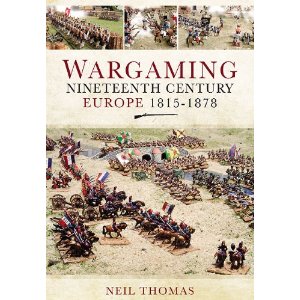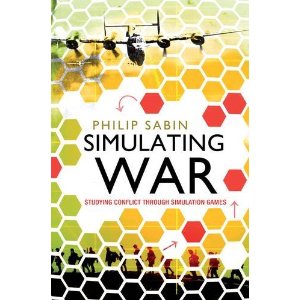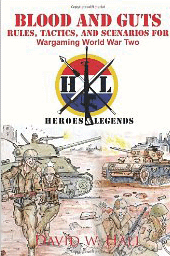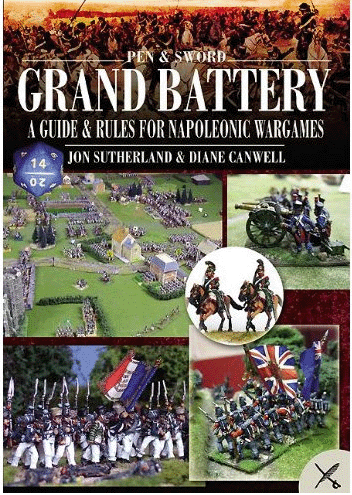The History of Wargaming Project
The project aims to make the largest possible collection of wargaming books and rules available to the modern reader. Ranging from second editions of wargaming classics, to professional wargaming rules used by the military and innovations in current wargaming.

|
|
Reviews of Wargaming Books/ Wargaming Rules
Daniel Mersey (1997) A Wargamer's Guide to the Anglo-Zulu Wars Ian Knight (2015) Marching to the Drums: Eyewitness Accounts of War from Kabul Massacre to the Siege of Mafikeng Bob Cordery (2017) The Portable Wargame and Developing the Portable Wargame Daniel Mersey (2017) A Wargamer's Guide to 1066 The Unparalled Invasion Jon Peterson (2012) Playing at the World Wargaming 19th Century Europe 1815-1878 Blood, Bilge and Iron Balls: Naval Wargame Rules for the Age of Sail Review of Philip Sabin Simulating war, studying conflict through simulation games Review of Blood and Guts, Wargaming World War Two Review of Grand Battery NapoleonicDaniel Mersey (1997) A Wargamer's Guide to the Anglo-Zulu Wars
This is a short 113 page book
covering the conflict. I like
it. Why? It covers all the battles, including the minor ones. The second
chapter is a succinct guide to information wargamers love; ORBATs, estimates
of effective rifle range, Chelmsford’s overview of the Zulu army etc. The
downside of the book is no maps. The colour plates might have been better
showing the different Zulu regiments to help bring the descriptions of the
uniforms of each to life. However, despite these drawbacks. I think it is a
good book.
Ian Knight (2015) Marching to the Drums: Eyewitness Accounts of War from Kabul Massacre to the Siege of Mafikeng
I really enjoyed this collection of readings from the
height of the British Empire. Having read many of these types of memoirs, I
found that a whole book an individual’s account often contains a lot of
additional background that is of less interest to me. This book uses very
well chosen selections, just are classic and I have read them before, others
were new to me. Each section includes an introduction that to set the
readings in context that is useful to those who have not wargamed the era as
much as I have. Excellent book, as one would expect from Ian Knight.
Bob Cordery (2017) The Portable Wargame and
Developing the Portable Wargame
These two short books have been well reviewed in the
wargaming press. They contain straightforward rules for playing games on
offset squares or hexes on a smaller playing area. The first book includes
rules for the 19th and 20th centuries. The second
extends this the ancient period. The rules are well written, clearly
explained and with much discussion of the design decisions. The books are
well written, but what would one expect from an author who has written
perhaps 500 articles on wargaming (and a few other books as well). My only
criticisms are minor; I prefer foot notes to end notes (as I do not like to
keep turning to the end of the book), I would have liked a few more pages in
both books with a few more sample scenarios. The books are a worthy and fun
addition to wargaming literature.
Daniel Mersey (2017) The Wargamer's Guide to 1066 and the Norman Conquest
I was kindly offered a copy for review by Pen and
Sword.
This book is part of a new wargaming series by Pen and
Sword, the well-established military history publishers.
The book is written by Daniel Mersey, an established
wargaming author. It aims to be a guide to wargaming one of the most famous
battles of all time, the Battle of Hastings (1066) and the associated
campaigns. The book certainly achieves that aim. The author has assembled
large amounts of information into a single book. As it says on the cover, it
clearly covers the background to the campaign, the armies, the potential
rules to use etc... I was particularly pleased to see the coverage of the
wider campaign of the Norman Conquest, rather than just focussing on the
single climatic battle on the south coast.
My minor criticism of the book is the omission of maps
of the key battles. It might have been also worth briefly discussing the
current state of research where the Battle of Hastings actually was.
If you are well informed about the battle already and
have carried out your own research, this book will not add much to your
understanding. However, if you are relatively new to this period of the
history, then this book is well worth getting.
The Unparalleled Invasion
While reading Clarke's (1995) The Tale of the Next Great War 1871-1914 I came across the horror
story to trump all horror stories. Clarke's book is a compendium of stories
about future wars, including the classic The Battle of Dorking (1871) which
describes the fall of England to a surprise land invasion.
The 'Unparalleled Invasion chapter' is an extract from
a 1910 book Certain Essays in History.
The story outlines the growing threat of China to dominate the world by
sheer population growth. Attacks on China fail, as it simply falls back from
coastal cities and then swamps any invading army with sheer numbers of
militia. The story continues until 1975, when the white skinned races decide
on a great truce. They then put huge armies on the edge of China on land and
large naval forces to blockade China's ports.
Then they drop using aircraft glass tubes all over
China. The Chinese realised too late they are under attack by biological
weapons. Chinese society breaks down and the attack continues on any
clusters of organisation in China. Eventually, armies enter the country and
shoot any survivors they encounter.
The story ends happily with all nations repopulating
China, but in a great melting pot of different nationalities, so the world
is a happier place. They even agree to ban biological weapons use in the
future. So all is well that ends well.
To me, that horror story put the efforts of
all the with 'black'
games I have ever played into perspective.
Jon Peterson (2012) Playing at the World/i>
ISBN 9780615642048 698 pages. paperback.  |
As the editor of wargaming books (some mentioned in the bibliography), I was asked by the author to do a review of this new book. The book is Jon Peterson’s magnum opus (great work) about the development of roleplaying up to the 1980s when the roleplaying games started to spread onto various computer platforms. The chapters explore the detailed chronology of wargaming events prior to the publication of Dungeons and Dragons (D+D), the development of the medieval fantasy game genre, the origin of the D+D rules and what happened in roleplaying after D+D was published. The source of much of the material is various archives of fanzines held in American, publically and in private collections. The list of games and magazines alone covers nine pages in the bibliography. The intellectual effort to pull together this vast plethora of material was a staggering undertaking. |
Thomas Neil (2012) Wargaming Nineteenth Century Europe 1815-1878
ISBN 978-1848846296 208 pages. hardback.  |
As the editor of many of wargaming books (some mentioned in the bibliography), I was asked by the publisher to do a review of this new book. The book is set out in a fairly standard format for such wargaming books as first devised by Featherstone in his writings. A chapter outlining political and military developments, a chapter explaining the rationale of the rules, a set of simple rules, examples of types of battle (e.g. meeting engagement, flanking attack), some army lists and nine historical battles. For me, one of the most interesting chapters is the one of Nineteenth- Century Wargaming. This aims to outline the reasoning behind the rules in the next chapter. It does this well, but like all wargamers, I always contest the writings of others on wargaming. For example the idea that, ‘A more serious problem with a system of simultaneous turns, is its lack of realism’, is clearly not defensible from the military perspective (otherwise there would be never be any ‘meeting engagements’ in the history of warfare). There are however, very sensible reasons to design wargames with alternative movement systems, such as to prevent disputes. The writer’s apparent views on leadership systems in wargaming as unnecessary could also be an area for discussion. The wargaming rules are at unit level, with infantry units having four bases, are straightforward and contained within just 8 pages. Morale is tested when a unit loses a base from firing, is a charging cavalry unit under fire or it has lost a melee. A D6 is rolled against the unit class or the unit loses a base e.g. an average unit needs 4, 5 or 6 on a D6 to avoid losing a base. The wargame scenario chapter has some interesting rules to add flavour to the type of battle. E.g. in the rearguard scenario, the attacker rolls 3-6 on a D6 per turn for the next attacker unit to arrive. |
Allen Abby (2011) Blood, Bilge and Iron Balls: Naval Wargame Rules for the Age of Sail
ISBN 978-1-84884-534-3 144 pages. hardback.  |
This is another book from the growing range of wargame related books by the well known military publishers, Pen and Sword. The author of the rules, Alan Abby, is clearly a Napoleonic naval wargamer who has taken the opportunity to get his own rules into print in book format. The book is 144 pages consisting of the main rules, some optional rules, scenarios and campaign rules. The rules are of medium complexity, allowing quite large fleet actions to be played out. Each ship being represented by an individual ship card showing crew, command, gunners, marines, cannon, masts etc... I tried a solo game of two ships aside and I was happily moving and firing within 30 minutes of picking up the book and moving to my wargames table. The campaign game is very good and very disappointing. It is a hypothetical campaign, with some interesting rules to help create meaningful naval battles. It includes an abstract map of trade routes, renue sheets, revenue to the crown, fleet reconnaissance, damage repair, etc... However, my own preference is for naval campaigns set solidly in the history of the Napoleonic Wars. Despite this I can see no problem in someone modifying the campaign game to set it in the Atlantic or some other geographical reality. The choice between a historically based campaign and a hypothetical one has always been a subject of debate in wargaming. Featherstone clearly likes historical, so did Fletcher Pratt, but Fred Jane and Phil Dunn created their own hypothetical arenas to test naval strategy. The bibliography is a bit disappointing, as it only lists work by Pen and Sword. What naval wargaming book cannot list Donald Featherstones Naval Wargames or Phil Dunn’s Sea Battles as sources of inspiration? |
Philip Sabin (2012) Simulating war, studying conflict through simulation games
ISBN 978-1-4411-8558-7. 363 pages. hardback.  |
As someone who has edited and written more wargaming books than most, I am always pleased when a new book says something original about wargaming. This book has a message. The message is micro board wargames are good for education and training. This book argues the case that wargames, in particular manual board games, are an invaluable tool for examining tactical and operational military history. The best of these games are worthy of inclusion of any study of military history. The first part of the book is a summary of the academic potential of wargaming techniques. The value of games to education and training is indisputable in the academic and business world. Phil takes that view and argues that wargaming can be used as tool to understand military history, supporting this with some academic evidence and his own experiences of using games as part of his teaching of military history at Kings College London. The second part of the book is a straightforward guide to building simple ‘micro-board games’. These are games that are smaller than even the smallest of commercial ‘folio’ type board games. Small and simple enough to be used as part of a two hour teaching session. Building on the work of Peter Perla’s Art of Wargaming and James Dunnigan’s The Complete Wagames Handbook, the book offers a recipe for analysing historical conflicts and distilling them into a board game format. The third part of the book gives a number of worked examples of such micro-board games. It includes games from the ancient world and World War II. There are also two tactical games; one about a battalion attack in WWII and the other about a company level assault on a built up area. The latter is still relevant to modern conflict. Although one could cut up the colour plates in the book to play the games, most people will download the game components from the book’s web site and print them themselves or use play them on the computer using the free Cyberbox software. The book may not appeal to all parts of the disparate hobby of wargaming. Some miniature (figure) gamers are sometimes overly keen with their mental model of wargaming that is based around a game with realistic terrain features using miniature figures to represent every battle. Such miniature wargamers may ‘scratch their heads’ about the large number of references to classic board games within this book. |
Blood and Guts, Rules, Tactics and Scenarios for Wargaming World War Two
by David Hall
ISBN 978-1-4620-2556-5. 354 pages. Softcover. Also available in hard back  |
Book Review of Blood and Guts (2011) by John Curry and Donald Featherstone December 2011 One of the perks of the History of Wargaming is receiving books and rules to review. Opening a new wargaming book by an author just arrived on the publishing scene is always exciting. This book is written by David Hall and is subtitled Rules, Tactics and Scenarios for Wargaming World War Two. The book contains a set of rules, descriptions on tactics, sample scenarios and a detailed explanation of the reasoning behind the rules. The book portrays unit level warfare, including infantry, tanks, armour and airpower. The rules use section level bases (Morschauser style) rather than the individual figure method used by many currently popular wargaming rules (Featherstone style). An interesting feature is the rolling for initiative in each movement phase and then rolling separately for who fires first (a method first used by Lionel Tarr, in his classic Tarr Rules). This can lead to a very dynamic game, particularly suitable for a solo wargamer (as Lionel Tarr was). The rules use D6, D8, D10, D12 and D20 which could be seen as an unnecessary complication, but the different dice have their purpose in the game. The rules have some standard features, such as rolls to hit and saving rolls, but they do have some interesting twists. Both reviewers noted the +1 on the mortar/ artillery rolls for each turn they fire at the same target. Thus reflecting the historical effect of fire as it is adjusted on to the target. The flame thrower rules include hits which destroy the tanks in 1 to 2 turns. This is correct as it can take time for the flames to disable a tank rather than the instant hit/ no hit in most low level rules. Tanks can be assaulted by infantry sections, discouraging individual tanks from moving to far away from their supporting infantry. It is also necessary for units to spot the enemy who have not yet fired on them, the rules make it historically hard for tanks to observe dug in anti-tank guns and infantry. The fire combat is pretty bloody and infantry in the open will be massacred if facing machine guns. Section level bases allow for national characteristics to be portrayed in the game; such as Italian units are weak, Japanese units are more willing to close assault tanks etc. |
Grand Battery a guide & rules for Napoleonic Wargames
 |
I was a little surprised to be asked to review the first of a new range of wargaming books by Pen and Sword Books, perhaps I should not have been. The authors are husband and wife team, who have written a number of military history books; they also run a residential wargaming centre in Norfolk. The hardback book is produced to a good standard, as one would expect from Pen and Sword books, full of images, packed full of information and including a new set of wargaming rules Grand Battery. The book has an introduction to European warfare 1792 to 1815 and discusses the armies. It was good to see that the weapons and tactics chapter covered more than the usual British/ French focus of many books covering the period. My stereotype is that standard Napoleonic books have pages devoted to British and French tactics and then a paragraph at the end saying the Austrians, Russians etc. had similar tactics. This work is much better balanced between the armies of the protagonists. The Grand Battery Wargaming Rules are designed for the divisional level Napoleonic battle, though they will work for army games. They use a card driven activation system for corps, with each corps having a card in a shuffled pack. Their sequence of activation, movement and firing is determined by the drawing of the cards. The authors implementation of the card activation system has an interesting twist, the other player can challenge once a turn based on their leadership rating. This represents a commander attempting to seize the initiative back. The rules aim to portray the battle from the divisional commander’s perspective, with emphasise on commander’s ratings, unit training and experience, giving orders, defenders resolve and morale. The rules are detailed, but are well explained and are supported by playing aids and play sheets. I have tried the rules and they work fine. Like all academic reviewers, I realise the need to be pedantic to demonstrate whatever academic reviewers are trying to do by being pedantic. The contents page has two of the chapters in the wrong order. The excellent photographs lack captions to explain what they show. The Bibliography omits the key work on Napoleonic Wargaming Paddy Griffith’s Napoleonic Wargaming for Fun (but perhaps as the editor of the latter work, I was bound to say that). I could ramble on for several pages saying my whim would be add another paragraph here, or subtract a paragraph there, but there is no need. The book is a good piece of scholarship, with an interesting set of rules for representing the divisional level Napoleonic battle. I like it and have no hesitation in recommending it to my fellow enthusiasts. |
The book is available from link
John Curry, Editor of the History of Wargaming Project April 2011